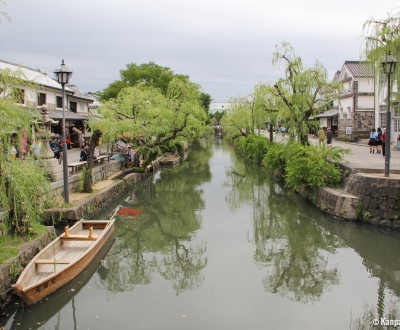Kurashiki
The Small Kyoto with Waterways
Kurashiki is a Japanese city with 476,000 inhabitants, located in Okayama prefecture, on Honshu Island. Its historical heart is crossed by the Takahashi River and canals. The district of Bikan witnessed glorious past years of feudal Japan and today houses several renowned art museums.
In the former commercial harbor, specialized in rice business, Kurashiki moored its boats on the docks for a long time, highlighting one the most typical and refined districts of the country.
During the Heian era (794-1185), these places were the battlefields of wars between the Taira and Minamoto families. After developing its full potential of a harbor city, the Tokugawa Shogunate took control over the city during the Edo era (1600-1868). During the Meiji Restauration (1868-1912), the docks were renovated, in parallel to the industrial revolution of the time. The modern side of Kurashiki was officially born the 1st of April,1928, and was afterward merged with Mabi and Funao.
Altough its history is not as rich or exhaustive as the other so-called "traditional" cities such as Kyoto or Nara, Kurashiki still has significant architectural appeal with will seduce amateurs. The municipality worked for several years to bury the electrical cables in the city center to recreate a medieval atmosphere and to fully accentuate the buildings’ architecture. Formerly, the coast was home to an important number of docks storing rice and other food items. Today, there are still big rocks at the corner of houses, which used to protect them from destruction due to freshly arrived shipments.
Bikan: the historical district
The Bikan area, which is very small, not only offers a beautiful walk along the waterways. Indeed here, lovers of art galleries can find real treasures, such as Ohara Museum of Art, which used to belong to the wealthiest family in the city. Its construction was based on the Greek Parthenon, and it houses numerous collections of art from Western artists such as Rodin and Picasso.
After visiting former merchants’ houses, which are now museums, it is strongly advised to explore the Museum of Folkcraftt and the Toy Museum. Popular at the beginning of the 20th century, a former cotton mill factory, today called "Ivy Square", perfectly represents the renewal and effort to reuse old buildings. Today, the ancient bricks are home to a high-end hotel 🏨 and a cotton museum.
One of the main attraction of the city is a boat ride on Kurashiki’s canal, wich enables one to experience Japan’s feudal atmosphere from another perspective. The boat goes under a small bridge, made of only one stone, at the 90° angle of the waterway. The tour lasts about 20 minutes and is embellished during spring season when blossoming cherry trees 🌸. The excursion is very touristy and participants are asked to wear traditional hats to stick with the district’s decor.
Ending the visit, parallel streets provide an additional, authentic trait. Quieter, they allow one to wander around in between traditional houses, which have not been converted into souvenir shops. Travelers can also stop at a ryokan, a Japanese guesthouse, which fits the calm and old-fashioned ambience of the city.

Kojima Peninsula
On the southern part of Kurashiki, the Kojima Peninsula offers breathtaking views of the Seto Inland Sea. Climbing Mount Washuzan allows one to admire the Great Seto Bridge, in reality made of six bridges, including three suspension bridges, linking Honshu and Shikoku Island since 1988, for a total of more than nine kilometers.
Viewpoints, temples, and the Brasilian theme park 🎡 Washuzan Highland can be discovered along— sometimes steep—hiking trails in this mountainous area. One can dive into very Japanese tourism, based on family hobbies and wellness.
Driving remains the only realistic way to go outside the city in order to find more nature, and it still takes about one hour. Buses and railway networks are not very effective, and taking a taxi is expensive. It is wiser to go to Kojima if you own/rent a car 🚙.

